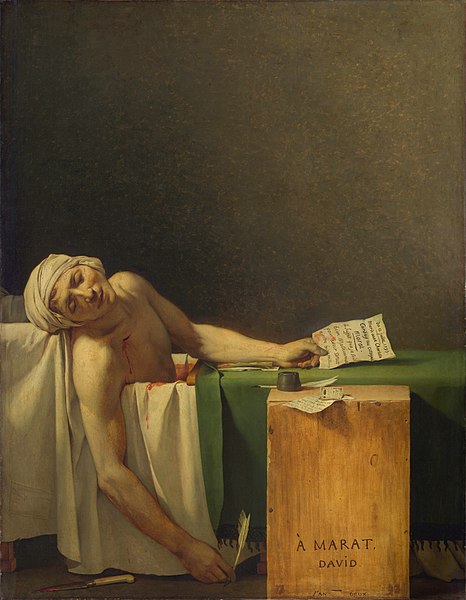The Death of Socrates
7:00 AM |
| Jacques-Louis David, The Death of Socrates, 1787 |
What would be a better way to set revolutionary ideals than to borrow from Classical Antiquities? A progressive philosopher himself, Socrates demonstrated the very essence of democracy and personal integrity that David had long been looking for. Wrongfully condemned for corrupting the minds of youths of Athens, Socrates chose to die for his beliefs rather than relinquish his principles and live in exile. In the eyes of the 18th-century French revolutionists, such heroic act was the exact manifestation of the spirit of the revolution -- to sacrifice oneself in resistance to an unjust regime.
The painting depicts the closing moment of Socrates's life. While delivering a discourse on the immortality of soul, (according to Plato), Socrates reaches for the hemlock cup. David really is the master of choosing moments. (Well, he is a master of many things). While he chooses to paint Marat at his last breath, here, David picks up the story right from the climax; nothing of calm or tranquility as we see in the Death of Marat, only a hero, who faces death with indifference and fortitude, as if in an Aeschylus tragedy.
A wide spectrum of emotions can be seen on the painting: from the grieving or perhaps sleeping Plato at the end of the bed, to the swirling disciples and slaves on the very right. Again, the details are what really grab you. Similar as in his The Lictors Bring to Brutus the Bodies of His Sons, here, one of the moaner's twisted feet also serve as the very expression of his high emotions. However, Socrates himself despises such weakness of emotionalism. Thus we only see two of his followers, Plato and Crito, who is grasping his master's leg, keep their self-control. But again, the figures who are reined by their emotions at the same time make the hero more resolute and dignified. Like we wouldn't know the scene of Marat's death, we have no way to verify the exact scene of Socrates' death either, (even Plato, who recorded the event was actually not present, due to illness). Only the painter, the one with the megaphone, gets to tell the story. In the case of David, his story is so convincing that we are moved and willing to believe, even when we know it's largely propaganda.
I'm amazed by such magic.
The painting depicts the closing moment of Socrates's life. While delivering a discourse on the immortality of soul, (according to Plato), Socrates reaches for the hemlock cup. David really is the master of choosing moments. (Well, he is a master of many things). While he chooses to paint Marat at his last breath, here, David picks up the story right from the climax; nothing of calm or tranquility as we see in the Death of Marat, only a hero, who faces death with indifference and fortitude, as if in an Aeschylus tragedy.
A wide spectrum of emotions can be seen on the painting: from the grieving or perhaps sleeping Plato at the end of the bed, to the swirling disciples and slaves on the very right. Again, the details are what really grab you. Similar as in his The Lictors Bring to Brutus the Bodies of His Sons, here, one of the moaner's twisted feet also serve as the very expression of his high emotions. However, Socrates himself despises such weakness of emotionalism. Thus we only see two of his followers, Plato and Crito, who is grasping his master's leg, keep their self-control. But again, the figures who are reined by their emotions at the same time make the hero more resolute and dignified. Like we wouldn't know the scene of Marat's death, we have no way to verify the exact scene of Socrates' death either, (even Plato, who recorded the event was actually not present, due to illness). Only the painter, the one with the megaphone, gets to tell the story. In the case of David, his story is so convincing that we are moved and willing to believe, even when we know it's largely propaganda.
I'm amazed by such magic.











0 comments